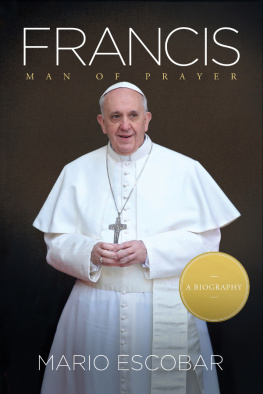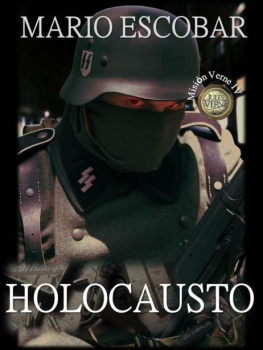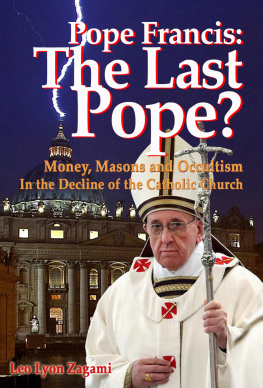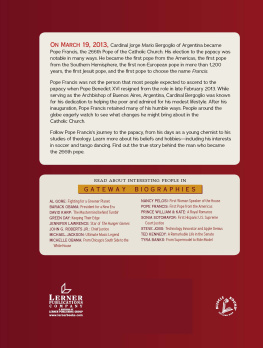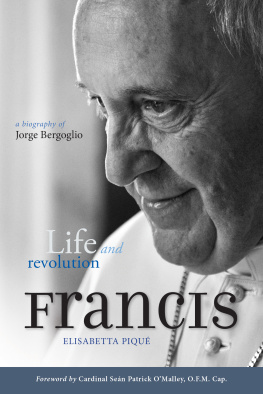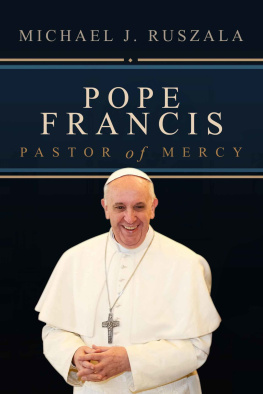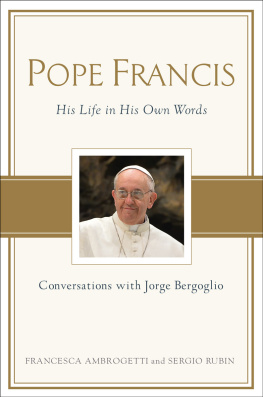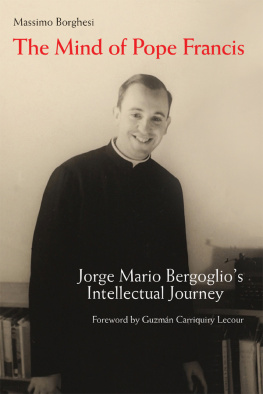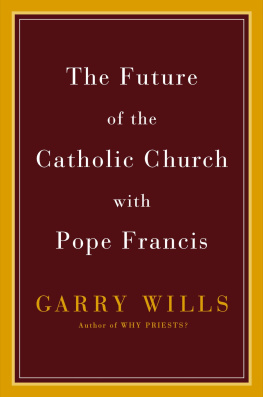FRANCIS
2013 Mario Escobar Golderos
Original Spanish publication 2013, Grupo Nelson, Inc.: Francisco: el primer papa latinoamericano
All rights reserved. No portion of this book may be reproduced, stored in a retrieval system, or transmitted in any form or by any meanselectronic, mechanical, photocopy, recording, scanning, or otherexcept for brief quotations in critical reviews or articles, without the prior written permission of the publisher.
Published in Nashville, Tennessee, by W Publishing Group. W Publishing is a registered trademark of Thomas Nelson, Inc.
Thomas Nelson, Inc. titles may be purchased in bulk for educational, business, fund-raising, or sales promotional use. For information, please e-mail SpecialMarkets@ThomasNelson.com.
English translation by Gretchen Abernathy.
Scripture quotations are taken from the New King James Version. 1982 by Thomas Nelson, Inc. Used by permission. All rights reserved.
Library of Congress Control Number: 2013935739
ISBN 978-0-8499-2203-9
Printed in the United States of America
13 14 15 16 17 RRD 5 4 3 2 1
For Elisabeth, Andrea, and Alejandro,my best decision
CONTENTS
WE WRITERS TRY TO BE GENIUSES WITH OUR WORDS, BUT there are publishers who are geniuses with their thoughts and ideas. Larry A. Downs is that kind of man. Thank you, Larry, for the connection we have despite the thousands of miles between us.
My deep admiration goes to the teams of Grupo Nelson and Thomas Nelson. They can work miracles, as I have witnessed over the past few weeks: Graciela Lelli, conductor of the orchestra, able to keep her cool in the midst of incredible stressI remember that walk on the beach in Miami with your shoes in your hand and your head in a book. Juan Carlos Martn Cobano is the kind of person who looks at things and sees what the rest of us mortals cannotgood work, my friend. Gretchen Abernathy, whom I have just recently gotten to know, is the perfect bridge between two cultures, meticulous and tirelessI hope to meet you in person. If there is any error in this book, it is entirely my own. Anything good is a result of these three geniuses.
The entire team of Thomas Nelson has worked ceaselessly. Thanks to Paula Major who has put up with this Spaniard and his literary hang-ups. Matt Baugher, thank you for betting on this book and taking it to the ends of the earth.
Thank you to Roberto Rivas, my Mexican friend, for believing so much in my books.
And I cannot forget the good work of the Silvia Bastos Literary Agency and the indefatigable Pau Centellas, who receives my countless e-mails with thousands of ideas. Thank you, Pau, for supporting me in everything. And thank you to Robert Downs for releasing this book to the entire world.
IT IS ONE OF THE MOST IMPRESSIVE CEREMONIES IN THE world: one hundred fifteen cardinals process from the Pauline Chapel under Michelangelos stunning frescos through the Sala Regia to seal themselves within one of the most beautiful rooms ever made by human hands, the Sistine Chapel. There they remain until, inspired by the Holy Spirit, they name the man who will lead the Catholic Church.
The cardinals proceed in order to the entrance of the Sistine Chapel and take their places. They sing the Veni Creator, an ancient prayer to invoke the Holy Spirit. They then swear, one by one, to closely observe the rules of the conclave. These rules can be reduced to two: 1) to faithfully fulfill Peters mandate if they are elected pope and 2) not to reveal the secrets related to the pontiffs election.
Once the ceremony of oaths has concluded, the Master of Papal Liturgical Celebrations orders in Latin, Extra omnes! which means Everyone else, out! The doors slam shut, and the cardinals begin their discussion.
Within the walls of Vatican City, time seems to stand still; the urgency and agitation of the modern world are nearly unthinkable in this, the worlds smallest state. Beyond the walls the commotion of over six thousand journalists and photographers with their cameras, all eager to be the first to capture a picture or file a report on the newly elected pope, remains distant to this most important religious meeting.
When the much anticipated fumata bianca, white smoke, rises from the chimney of the Sistine Chapel, the excitement among the crowds in St. Peters Square explodes into a great festival of the faith for Catholics. Television, radio, and newspaper media around the globe anxiously await the appearance of the new pope in the central balcony. Meanwhile, the new pope prepares himself in the Room of Tears, where, before revealing himself to the world, he undresses before God.
After a brief interval, which for many believers around the world feels interminable, the newly elected pope greets the worldwide Catholic Church. He raises his voice and pronounces the Urbi et Orbi (to the City [Rome] and to the World) blessing. St. Peters Square resounds with a deafening clamor, and much of the world studies the face of the new pope from television and computer screens.
When Pope Francis, the Cardinal Jorge Mario Bergoglio, with arms uplifted and palms open to the crowd, spoke his first words, St. Peters Square grew instantly silent:
Brothers and sisters, good evening!
You know that it was the duty of the Conclave to give Rome a Bishop.... The diocesan community of Rome now has its Bishop....
I would like to give the blessing, but firstfirst I ask a favour of you: before the Bishop blesses his people, I ask you to pray to the Lord that he will bless me: the prayer of the people asking the blessing for their Bishop.
Not long ago Pope Francis had been virtually unknown, not only to the world but also to the vast majority of Catholic believers. So many questions and doubts have arisen regarding the direction he will take the Catholic Church in the next few years: Will Pope Francis be the one to bring the Catholic Church into the twenty-first century? Will he become the first to authorize the marriage of priests? How will he handle the scandals that have beleaguered the Catholic Church in the past few years? Will Pope Francis maintain his stance of support for the poor? Will he encourage greater interreligious dialogue?
To answer these and other questions, this book will delve into the life, words, and thoughts of one of the most powerful men on earth.
The background of Jorge Mario Bergoglio, the first Latin American to be named pope, will reveal the influences that have shaped him throughout his extensive ecclesiastical and personal life. His formation as a Jesuit and his academic concentrations in the world of science and letters, his ecumenical disposition toward other faiths, his willingness to dialogue with other religions, and his commitment to help the poor will all undoubtedly leave their mark on the third pontificate of the twenty-first century and of the new millennium.
Pope Franciss words in one of his first declarations as pope could not be more straightforward:
Those words came to me: the poor, the poor. Then, right away, thinking of the poor, I thought of Francis of Assisi. Then I thought of all the wars, as the votes were still being counted, till the end. Francis is also the man of peace. That is how the name came into my heart.
Shy, aloof, a man of few words, he flees the pursuit of a career; yet it is precisely that quality which is considered one of his greatest merits. His austerity and frugality, together with his intense spirituality, are details that increasingly make him a candidate for the papacy.
SANDRO MAGISTER, VATICAN EXPERT, LESPRESSO

